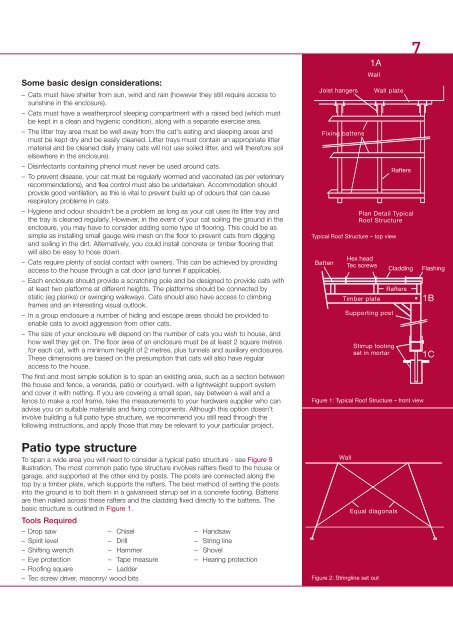How to build a cat enclosure - City of Tea Tree Gully
How to build a cat enclosure - City of Tea Tree Gully
How to build a cat enclosure - City of Tea Tree Gully
Create successful ePaper yourself
Turn your PDF publications into a flip-book with our unique Google optimized e-Paper software.
Some basic design considerations:– Cats must have shelter from sun, wind and rain (however they still require access <strong>to</strong>sunshine in the <strong>enclosure</strong>).– Cats must have a weatherpro<strong>of</strong> sleeping compartment with a raised bed (which mustbe kept in a clean and hygienic condition), along with a separate exercise area.– The litter tray area must be well away from the <strong>cat</strong>'s eating and sleeping areas andmust be kept dry and be easily cleaned. Litter trays must contain an appropriate littermaterial and be cleaned daily (many <strong>cat</strong>s will not use soiled litter, and will therefore soilelsewhere in the <strong>enclosure</strong>).– Disinfectants containing phenol must never be used around <strong>cat</strong>s.– To prevent disease, your <strong>cat</strong> must be regularly wormed and vaccinated (as per veterinaryrecommendations), and flea control must also be undertaken. Accommodation shouldprovide good ventilation, as this is vital <strong>to</strong> prevent <strong>build</strong> up <strong>of</strong> odours that can causerespira<strong>to</strong>ry problems in <strong>cat</strong>s.– Hygiene and odour shouldn’t be a problem as long as your <strong>cat</strong> uses its litter tray andthe tray is cleaned regularly. <strong>How</strong>ever, in the event <strong>of</strong> your <strong>cat</strong> soiling the ground in the<strong>enclosure</strong>, you may have <strong>to</strong> consider adding some type <strong>of</strong> flooring. This could be assimple as installing small gauge wire mesh on the floor <strong>to</strong> prevent <strong>cat</strong>s from diggingand soiling in the dirt. Alternatively, you could install concrete or timber flooring thatwill also be easy <strong>to</strong> hose down.– Cats require plenty <strong>of</strong> social contact with owners. This can be achieved by providingaccess <strong>to</strong> the house through a <strong>cat</strong> door (and tunnel if applicable).– Each <strong>enclosure</strong> should provide a scratching pole and be designed <strong>to</strong> provide <strong>cat</strong>s withat least two platforms at different heights. The platforms should be connected bystatic (eg planks) or swinging walkways. Cats should also have access <strong>to</strong> climbingframes and an interesting visual outlook.– In a group <strong>enclosure</strong> a number <strong>of</strong> hiding and escape areas should be provided <strong>to</strong>enable <strong>cat</strong>s <strong>to</strong> avoid aggression from other <strong>cat</strong>s.– The size <strong>of</strong> your <strong>enclosure</strong> will depend on the number <strong>of</strong> <strong>cat</strong>s you wish <strong>to</strong> house, andhow well they get on. The floor area <strong>of</strong> an <strong>enclosure</strong> must be at least 2 square metresfor each <strong>cat</strong>, with a minimum height <strong>of</strong> 2 metres, plus tunnels and auxiliary <strong>enclosure</strong>s.These dimensions are based on the presumption that <strong>cat</strong>s will also have regularaccess <strong>to</strong> the house.The first and most simple solution is <strong>to</strong> span an existing area, such as a section betweenthe house and fence, a veranda, patio or courtyard, with a lightweight support systemand cover it with netting. If you are covering a small span, say between a wall and afence <strong>to</strong> make a ro<strong>of</strong> frame, take the measurements <strong>to</strong> your hardware supplier who canadvise you on suitable materials and fixing components. Although this option doesn'tinvolve <strong>build</strong>ing a full patio type structure, we recommend you still read through thefollowing instructions, and apply those that may be relevant <strong>to</strong> your particular project.Patio type structureTo span a wide area you will need <strong>to</strong> consider a typical patio structure - see Figure 9illustration. The most common patio type structure involves rafters fixed <strong>to</strong> the house orgarage, and supported at the other end by posts. The posts are connected along the<strong>to</strong>p by a timber plate, which supports the rafters. The best method <strong>of</strong> setting the postsin<strong>to</strong> the ground is <strong>to</strong> bolt them in a galvanised stirrup set in a concrete footing. Battensare then nailed across these rafters and the cladding fixed directly <strong>to</strong> the battens. Thebasic structure is outlined in Figure 1.Tools Required– Drop saw – Chisel – Handsaw– Spirit level – Drill – String line– Shifting wrench – Hammer – Shovel– Eye protection – Tape measure – Hearing protection– Ro<strong>of</strong>ing square – Ladder– Tec screw driver, masonry/ wood bitsJoist hangersJoist hangersFixing battensFixing battensBatten1AWall1AWallWall plateRaftersPlan Detail TypicalRo<strong>of</strong> StructurePlan Detail TypicalRo<strong>of</strong> StructureHex headTec screwsTimber plate7RaftersCladdingSupporting postRaftersTimber plateWall plateTypical Ro<strong>of</strong> Structure – <strong>to</strong>p viewBattenHex headTec screwsSupporting postStirrup footingset in mortarStirrup footingset in mortarRaftersCladdingFigure 1: Typical Ro<strong>of</strong> Structure – front viewWallEqual diagonalsFigure 2: Stringline set outFlashing1BFlashing1B1C1C

















